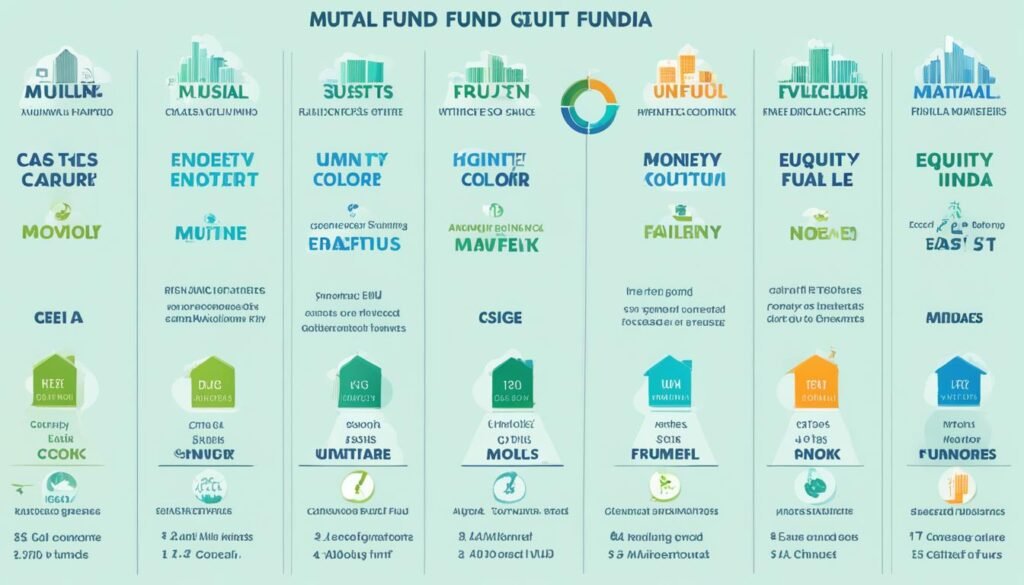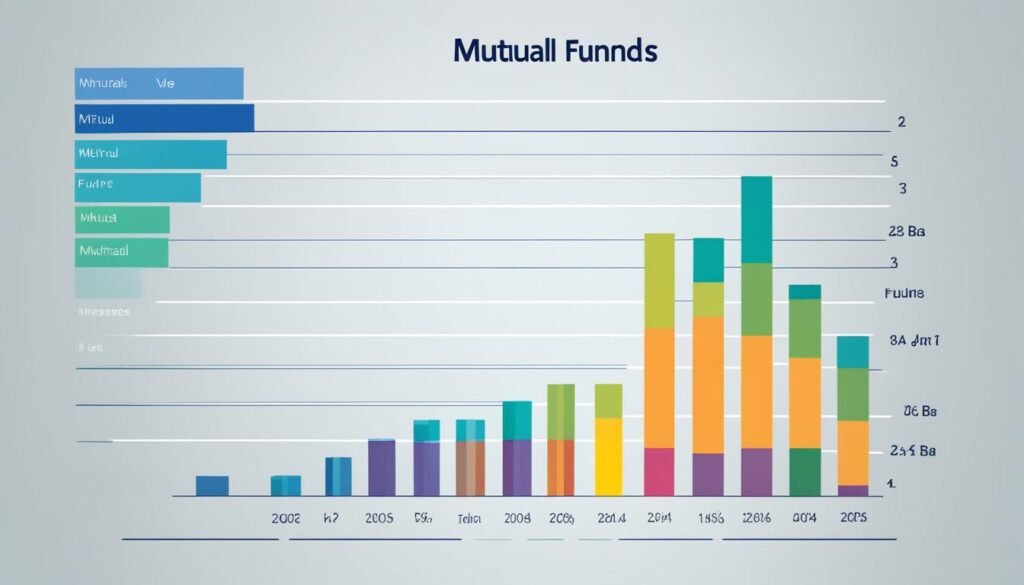Investing can feel like a rollercoaster, full of ups and downs. But, there’s a way to ride it with confidence. By choosing top-performing mutual funds in India, you can reduce risks and aim for long-term success.
Mutual funds are a top choice for those wanting to grow their wealth over time. They offer a variety of funds for different risk levels and goals. Finding the best mutual funds is key to reaching your financial dreams.
Key Takeaways
- Discover the top 10 best mutual funds in India for 2024, hand-picked for their consistent performance and potential for long-term growth.
- Understand the different types of mutual funds and how they align with various investment objectives and risk tolerances.
- Learn the critical factors to consider when selecting mutual funds, including performance history, expense ratios, and fund manager track records.
- Explore the benefits of investing in top-performing mutual funds, such as achieving financial goals faster and the potential for higher returns.
- Uncover the best mutual fund options for diversified portfolios, dividend income, and systematic investment plans (SIPs).
Understanding Mutual Funds
Mutual funds collect money from many investors. This money is then managed by experts who spread it across different assets. These funds can be about stocks, bonds, or a mix of both, known as hybrid funds. Each type of mutual fund has its own level of risk and goals, fitting the needs of different investors.
Types of Mutual Funds
Equity mutual funds mainly invest in stocks, aiming for long-term growth. Debt mutual funds focus on bonds and other stable investments, offering a safer choice. Hybrid funds mix stocks and bonds, aiming for a balance between growth and stability.
Investment Objectives and Risk Tolerance
Choosing a mutual fund means thinking about your financial goals and how much risk you can handle. Equity funds are for those looking to grow their money over time. Debt funds are better for those who want a steady income and less risk. The decision between growth funds and income funds depends on if you want to reinvest earnings or get regular income.
| Mutual Fund Category | Investment Objective | Risk Profile |
|---|---|---|
| Equity Funds | Long-term capital appreciation | Moderately High to High |
| Debt Funds | Regular income and capital preservation | Low to Moderate |
| Hybrid Funds | Balanced growth and income | Moderate |
Knowing about the various mutual funds and their goals and risks helps investors make better choices. This way, they can work towards their financial goals and manage their risk well, leading to long-term wealth.

Factors to Consider When Selecting Mutual Funds
When you invest in mutual funds, you need to think about several important things. These help make sure the funds match your financial goals and how much risk you can take. Key elements to look at include:
Investment Objectives Alignment
First, make sure the mutual fund’s goals match yours. Are you looking for growth, income, or a mix? The fund should fit your investment needs and likes.
Fund’s Performance History
Check how the mutual fund has done in the past. Look for funds that have done well over time, even when markets were down. This shows they might give you steady returns.
Expense Ratio
The expense ratio is the yearly fees the fund charges. Choosing funds with lower fees can help you earn more money. This is because you keep more of your investment.
| Mutual Fund Scheme | 1-Year Performance | Portfolio Allocation |
|---|---|---|
| Axis Bluechip Fund | 16.5% | Equities: 90%, Debt: 10% |
| Nippon India Growth Fund | 14.2% | Equities: 85%, Debt: 15% |
| SBI Bluechip Fund | 15.8% | Equities: 92%, Debt: 8% |
| Mirae Asset Great Consumer Fund | 17.3% | Equities: 88%, Debt: 12% |
| HDFC Midcap Opportunities Fund | 16.1% | Equities: 93%, Debt: 7% |
Don’t forget to look at the mutual fund’s tax effects, the manager’s history, and the risk and return it offers. This helps you pick funds that meet your investment objectives, risk tolerance, and financial goals.
Evaluating Top Mutual Fund Schemes
Fund Manager’s Track Record
Looking at the top mutual fund schemes, the fund manager’s track record is key. Investors should watch how the fund does in both up and down markets. This shows the manager’s skill in different conditions. Checking how different schemes from the same manager perform also gives clues about their strategies and decisions.
RankMF is India’s only tech-driven research platform. It looks at 20 million data points to suggest the best mutual fund investments. Their engine rates and ranks schemes not just by past performance but also by other factors for a full check.
RankMF aims to improve how investors pick and manage their funds. It lets you easily switch to better schemes. The platform uses data and science to offer pre-set investment options that match your risk level or time frame.
| Mutual Fund Scheme | Fund Manager | 1-Year Performance | Portfolio Allocation |
|---|---|---|---|
| Axis Bluechip Fund | Sudhanshu Asthana | 15.2% | Reliance Industries, HDFC Bank, Infosys |
| Mirae Asset Great Consumer Fund | Ankit Jain | 12.8% | Titan, Marico, Nestle India |
| Parag Parikh Flexi Cap Fund | Rajeev Thakkar | 14.5% | Alphabet, Amazon, Suzuki Motor |
| Invesco India Growth Fund | Neelesh Surana | 13.9% | Infosys, Tata Consultancy Services, HDFC Bank |
| ICICI Prudential Bluechip Fund | Sankaran Naren | 14.2% | Reliance Industries, HDFC Bank, Infosys |
It’s important to check how mutual fund schemes perform over time. Look at their results over one, three, or five years. This shows how they do in different markets. Risk-adjusted returns help see how well the scheme balances returns with risk. It’s also key to pick a scheme that matches your financial goals.
The fund manager’s experience and how long they’ve been in the job matter a lot for scheme performance. The CRISIL Mutual Fund Ranking (CMFR) started in June 2000. It looks at funds in equity, debt, and hybrid classes. The ranking goes from 1 to 5, with 1 meaning ‘very good performance’.

Consistency and Risk Evaluation
When looking at mutual funds, it’s key to focus on their consistent performance. The best mutual funds in India have often beaten their benchmarks and peers over three to five years. They show a strong track record of giving steady and reliable returns. This makes them great choices for those wanting dependable investments.
It’s also important to look at the risk and volatility of a mutual fund. Things like standard deviation and beta show how risky a fund is and how it handles market drops. Funds with lower risk and better returns are usually better, offering a stable investment experience.
Assessing Volatility and Risk Metrics
To check a mutual fund’s consistency and risk, look at these key metrics:
- Standard Deviation: This shows how much a fund’s returns change. Funds with lower standard deviations are less risky, meaning they perform more steadily.
- Beta: Beta measures how much a fund moves with the market. A beta under 1 means the fund is less volatile than the market. A beta over 1 means it’s more volatile.
By looking at these metrics, investors can understand a fund’s risk level. This helps them make choices that fit their investment goals and how much risk they can handle.
| Mutual Fund | 1Y Returns | AUM (₹Cr) | Standard Deviation | Beta |
|---|---|---|---|---|
| Invesco India Arbitrage Fund Direct Growth | 8.4% | 16,489 | 0.60 | 0.05 |
| Tata Arbitrage Fund Direct Growth | 8.4% | 11,519 | 0.58 | 0.06 |
| Bank of India Overnight Fund Direct Growth | 6.9% | 109 | 0.10 | 0.01 |
| Mirae Asset Overnight Fund Direct Growth | 6.8% | 581 | 0.11 | 0.01 |
| Axis Overnight Fund Direct Growth | 6.8% | 7,224 | 0.09 | 0.01 |
| Quant Overnight Fund Direct Growth | 7.3% | 242 | 0.12 | 0.02 |
| Kotak Equity Arbitrage Fund Direct Growth | 8.6% | 47,999 | 0.55 | 0.04 |
| Edelweiss Arbitrage Fund Direct Growth | 8.4% | 11,876 | 0.57 | 0.05 |
| Axis Arbitrage Fund Direct Growth | 8.3% | 5,237 | 0.56 | 0.04 |
The table shows the 1-year returns, assets, standard deviation, and beta of some top mutual funds in India. This info helps investors see how consistent and risky these funds are. It helps them make smart investment choices that match their financial goals and risk comfort.
Tax Implications of Mutual Fund Investments
Investing in mutual funds can lead to earnings from capital gains and dividends. The tax on these earnings varies by the type of mutual fund and how long you hold it. Knowing how mutual funds are taxed is key to a good investment plan and getting the most from your money.
Capital Gains Taxation
Equity Mutual Funds: If you hold equity mutual funds for less than a year, you pay 15% tax on gains. For more than a year, gains over ₹1 lakh are taxed at 10% without indexation.
Debt Mutual Funds: Short-term gains are taxed as part of your income. Long-term gains are taxed at 20% with indexation until March 31, 2023.
Hybrid Mutual Funds: Taxes depend on the fund’s equity part. It follows the rules of equity or debt funds.
Dividend Taxation
Dividends from mutual funds are taxed based on your income tax rate. Also, a 10% TDS is taken when the total dividend is over ₹5,000 in a year.
Securities Transaction Tax (STT)
A 0.001% Securities Transaction Tax (STT) is charged on buying or selling equity or hybrid equity mutual fund units.
Tax Implications on SIPs
For SIP investments, long-term capital gains on units over a year are tax-free up to ₹1 lakh. Short-term gains are taxed at 15%.
Understanding mutual fund taxes helps investors make smart choices. It’s important to think about the fund type and holding time to reduce taxes and increase your returns.
“Investing in mutual funds can be a tax-efficient way to grow your wealth, but it’s crucial to understand the tax implications to make the most of your investments.”
Benefits of Investing in Top Mutual Funds
Investing in top mutual funds can help you reach your financial goals faster. These funds often give better returns than others. By picking the best mutual funds, you can work towards your long-term goals, like building wealth or saving for retirement.
Investing in the best mutual funds can lead to higher returns than saving in banks. This makes them a great option for those wanting to grow their wealth over time. The chance for higher returns from top mutual funds is key to reaching your financial goal achievement.
Achieving Financial Goals
The benefits of top mutual funds go beyond just higher returns. They can help you meet your financial goals. By choosing the right mutual funds that match your goals and risk level, you can create a portfolio for steady long-term returns.
“Investing in the best mutual funds can be a powerful tool for achieving your financial goals, whether it’s saving for retirement, a down payment on a house, or your child’s education.”
Potential for Higher Returns
Top mutual funds can offer higher returns than traditional investments. This makes them a good choice for those looking to grow their wealth. By using the skills of professional managers and their strategies, these funds can take advantage of market chances and perform well over time.
| Mutual Fund Scheme | 1-Year Return | Portfolio Allocation |
|---|---|---|
| Axis Bluechip Fund | 18.5% | Larsen & Toubro, HDFC Bank, Infosys |
| Mirae Asset Great Consumer Fund | 16.2% | ITC, Hindustan Unilever, Britannia Industries |
| Invesco India Growth Fund | 15.7% | Reliance Industries, HDFC Bank, Infosys |
By choosing top mutual funds, investors can aim for higher returns. These returns can help you achieve your financial goal achievement over the long term.
Best Mutual Funds in India
Mutual funds are a top choice for investors in India. They offer diversification, expert management, and the chance for growth. The latest CRISIL rankings show some of the best mutual funds in India for 2024 are:
- HDFC ELSS Tax Saver, SBI Long Term Equity Fund, and ITI ELSS Tax Saver Fund in the ELSS category
- JM Flexi Cap Fund and Bank of India Flexi Cap Fund in the flexi-cap fund segment
- HDFC Focused 30 Fund and Mahindra Manulife Focused Fund in the focused fund category
- SBI Nifty 50 ETF, UTI S&P BSE Sensex ETF, SBI S&P BSE Sensex ETF, and ICICI Prudential S&P BSE Sensex ETF among index funds and ETFs
These top performing mutual funds have shown strong returns. They are great for investors wanting to boost their best mutual funds in India portfolios.
| Mutual Fund Scheme | 1-Year CAGR | Portfolio Allocation |
|---|---|---|
| Motilal Oswal Focused Fund | 29.52% | Top Holdings: Infosys, HDFC Bank, Reliance Industries |
| Motilal Oswal Nifty 50 Index Fund | 26.43% | Allocation: Nifty 50 Index Constituents |
| Motilal Oswal Midcap Fund | 65.91% | Top Holdings: Edelweiss Financial Services, Alkyl Amines Chemicals, Alkem Laboratories |
| Motilal Oswal Nifty Midcap 150 Index Fund | 56.06% | Allocation: Nifty Midcap 150 Index Constituents |
| Motilal Oswal Nifty Smallcap 250 Index Fund | 62.58% | Allocation: Nifty Smallcap 250 Index Constituents |
Other top performing mutual funds in India include Motilal Oswal BSE Financials ex Bank 30 Index Fund and more. These funds have done well over the past year.
Investors should think about these best mutual funds in India for a diverse portfolio. They should match their investment goals and how much risk they can take.
Top Equity Mutual Funds
Investing in the Indian equity market is popular among those looking for a diversified and managed portfolio. For 2024, some equity mutual funds stand out for their consistent performance and strong track record.
Portfolio Allocation and Performance
Nippon India Large Cap Fund, ICICI Prudential Bluechip Fund, and JM Large Cap Fund lead in the large-cap fund category. They offer a mix of sectors and have returns from 36.76% to 43.24% annually. In the large and mid-cap fund area, ICICI Prudential Large & Mid Cap Fund, Bandhan Core Equity Fund, and Quant Large and Mid Cap Fund show strong results, with returns between 44.82% and 67.3%.
Motilal Oswal Midcap Fund, Quant Mid Cap Fund, and ITI Mid Cap Fund are top picks for mid-cap exposure. They have returns up to 54.89% annually. ITI Multi Cap Fund also stands out with a 47.11% return in the last year.
| Fund Name | Category | 1-Year Returns | Portfolio Allocation |
|---|---|---|---|
| Nippon India Large Cap Fund | Large Cap | 36.76% | Top holdings include Reliance Industries, HDFC Bank, and Infosys. |
| ICICI Prudential Bluechip Fund | Large Cap | 41.92% | Diversified across sectors like IT, Financials, and Consumer Discretionary. |
| ICICI Prudential Large & Mid Cap Fund | Large & Mid Cap | 44.82% | Invested in a mix of large-cap and mid-cap stocks across industries. |
| Motilal Oswal Midcap Fund | Mid Cap | 54.89% | Focuses on growth-oriented mid-cap companies with strong fundamentals. |
| ITI Multi Cap Fund | Multi Cap | 47.11% | Diversified across market capitalizations and sectors for balanced exposure. |
These top equity mutual funds have shown consistent performance and diversified portfolios. They cover different market sizes, sectors, and industries. This makes them great options for investors looking for growth and capital appreciation in the Indian equity market.
“Investing in top-performing equity mutual funds can be a strategic way to participate in the growth of the Indian stock market and potentially generate long-term wealth.”
Top Debt Mutual Funds
Equity mutual funds get a lot of attention, but debt mutual funds in India are key for diversifying your investments and earning steady income. They are a stable choice for those who want consistent returns without taking big risks. Some of the best debt funds for 2024 are:
- ICICI Prudential Income Fund: This fund has a 1-year return of 4.8% and a size of ₹1,312 Cr. It shows it can handle different interest rates well.
- Aditya Birla Sun Life Dynamic Bond Fund: With a 1-year return of 7.9% and a size of ₹1,709 Cr, it has shown it can work well in various markets.
- Kotak Medium Term Fund: It has a 1-year return of 6.3% and a big fund size of ₹5,433 Cr. This fund offers a good mix of fixed income investments.
These debt mutual funds have given strong returns, making them great for those looking for steady income in their portfolios.
| Mutual Fund | 1-Year Return | Fund Size (Cr) |
|---|---|---|
| ICICI Prudential Income Fund | 4.8% | ₹1,312 |
| Aditya Birla Sun Life Dynamic Bond Fund | 7.9% | ₹1,709 |
| Kotak Medium Term Fund | 6.3% | ₹5,433 |
| SBI Magnum Gilt Fund | 8.3% | ₹8,720 |
| ICICI Prudential All Seasons Bond Fund | 8.2% | ₹12,592 |
When picking debt mutual funds, look at their goals, risk level, costs, and past results. Choosing the right funds can make your investments more stable and increase your income.
Debt funds offer many benefits, like possibly earning more than traditional savings accounts, being tax-efficient, and managing interest rate risks. They are a smart choice for anyone looking to add stability to their investments or diversify their portfolio.
Best SIP Mutual Funds
Investing in mutual funds through systematic investment plans (SIPs) is a smart way to grow your wealth over time. With SIPs, you invest a set amount regularly. This strategy helps you grow your money and benefit from compounding. Some top SIP mutual funds in India for 2024 are:
- HDFC Equity Fund
- Axis Long Term Equity Fund
- Mirae Asset Great Consumer Fund
These funds have shown strong performance over the years. They are great for investors who want to grow their money through regular, disciplined investments.
Choosing the best SIP mutual funds in India means looking at things like expense ratios and performance over time. Investors can see their money double with SIPs over the investment period.
SIPs come in different types, like Regular SIP and Flexible SIP. Each type has its own benefits. The tax on SIP redemptions depends on if it’s a long-term or short-term investment. Long-term gains are taxed at 10% if over one lakh.
| Mutual Fund | 3-Year Return | 5-Year Return |
|---|---|---|
| Tata AIA Top 200 Fund | – | 27.30% |
| Virtue II PNB Metlife | – | 23.76% |
| Quant Small Cap Fund Direct Plan-Growth | 67.91% | 22.49% |
| Tata Digital India Fund Direct-Growth | 37.81% | 22.25% |
| DSP Government Securities Direct Plan-Growth | 5.88% | 8.34% |
| SBI Technology Opportunities Fund Direct-Growth | 36.75% | 20.84% |
| Aditya Birla Sun Life Medium Term Direct Plan-Growth | 14.17% | 8.51% |
| Aditya Birla Sun Life Digital India Fund Direct-Growth | 40.10% | – |
| ICICI Prudential Technology Direct Plan-Growth | 51.73% | – |
| SBI Magnum Gilt Fund Direct-Growth | 6.12% | 8.07% |
SIPs offer many benefits like being open-ended and flexible. They allow compound interest to grow your money. You can buy more units when prices are low. You can track your investments online and start with a small amount.
When choosing SIPs, think about the time needed to see returns and how much risk you can take. Look for funds with low fees and know about any exit fees. Diversifying your portfolio is key to success.
“The key to successful SIP investing is to stay disciplined and consistent with your investment plan, regardless of market conditions.”
By picking the best SIP mutual funds, you can create a diverse portfolio. This can help you reach your financial goals and enjoy the benefits of systematic investing.
Best Mutual Funds in India for Dividend Income
For those looking for a steady income from their mutual funds, some top dividend funds in India are great options. These funds have shown they can pay dividends regularly, offering potential for income and growth over time.
Top choices include the ICICI Prudential Dividend Yield Fund, Mirae Asset Dividend Yield Fund, and Invesco India Growth & Dividend Yield Fund. They’ve given returns of 22.35% to 31.98% over three years. They focus on companies that pay good dividends.
| Mutual Fund | 1-Year Returns | Fund Size (₹ Crore) | Dividend Yield |
|---|---|---|---|
| ICICI Prudential Dividend Yield Fund | 20.5% | ₹5,617 | 4.2% |
| Mirae Asset Dividend Yield Fund | 27.4% | ₹3,710 | 3.8% |
| Invesco India Growth & Dividend Yield Fund | 61.9% | ₹893 | 3.1% |
These mutual funds for dividend income put 75%-80% of their money in companies that pay good dividends. The rest goes into stocks that could grow in value. This mix helps investors reach their financial goals with a balanced approach.
If you’re looking for regular income or want to boost your portfolio, these dividend-paying funds in India are worth a look. They can be part of a solid investment plan.
Key Considerations for Investing in Dividend-Paying Mutual Funds
- Make sure the fund’s goals and risk level match your financial goals and how much risk you can take.
- Look at the fund’s past performance, especially during tough times, to see how it handles volatility.
- Check the fund’s expense ratio. Lower fees mean more money for you over time.
- See how the fund manager has done in the past and their strategy for steady dividends.
Choosing the right mutual funds for dividend income in India can give you regular income and the chance for your money to grow over time.
“Investing in dividend-paying mutual funds can be a smart strategy for those seeking a combination of regular income and long-term growth.”
Mutual Fund Investment Strategies
Investing in mutual funds is a smart way to grow your money and reach your financial goals. It’s all about using strategies like diversification and asset allocation. By mixing different types of investments, you can lower your risk and increase your chances of making money.
Choosing the right mix of investments depends on how much risk you can take and what you want to achieve. Top mutual funds in India use these strategies to give you steady and good returns.
Diversification and Asset Allocation
Diversification is key in mutual fund investing. It means spreading your money across various sectors and types of investments. This way, you’re not just betting on one thing. It helps you manage risk and could lead to better returns over time.
Asset allocation is also vital. It means putting your money where it fits best based on your risk level, how long you can wait for your money to grow, and your financial goals. This approach balances the chance for growth with the need for stability. It makes sure your investments match your risk tolerance.
- Retail investors added a record 4 million equity mutual fund folios in June 2024, totaling 133 million folios, according to AMFI.
- Equity mutual fund AUM increased by 23% to Rs 27.67 lakh crore by June 2024.
- In June, sectoral and thematic mutual funds contributed over 50% of the total inflows in equity mutual funds, with Rs 22,351 crore coming from these categories out of total equity inflows of Rs 40,608 crore.
Using diversification and asset allocation, you can create a strong mutual fund portfolio. This portfolio aims for steady and stable returns over the long term while keeping risk in check.
“Mutual funds offer professional management expertise for investors who may lack the time or knowledge to oversee their investments.”
Choosing the Right Mutual Fund Scheme
When you invest in mutual funds, it’s key to match your goals and how much risk you can handle. The best scheme for you should meet your financial aims, like growing wealth, earning regular income, or keeping your capital safe.
First, think about how much risk you can take on. Do you want a stable investment or are you okay with more risk for a chance at higher returns? Your answer will help pick the right mutual fund scheme for you.
Aligning with Investment Goals and Risk Tolerance
After knowing your goals and how much risk you can handle, look for mutual funds that fit your needs. For example, if you aim to grow your wealth and are okay with high-risk investments, consider equity mutual funds. These can be large-cap, mid-cap, or multi-cap funds.
If you want regular income and prefer low-risk investments, debt mutual funds might be better for you. Options like liquid, short-term, or medium-term funds could be good choices.
Remember, mutual funds aren’t the same for everyone. The best one for you depends on your financial situation, goals, and how much risk you can take. By matching your investments with your goals and risk level, you can make the most of your mutual fund portfolio and reach your financial goals.
“The key to successful mutual fund investing is to choose funds that match your investment goals and risk tolerance, not to chase the latest hot trend or fad.” – John Bogle, Founder of The Vanguard Group
Conclusion
Mutual fund investments are getting more popular in India. They offer many ways to reach financial goals. By looking at things like goals, past results, costs, and risk levels, investors can pick the best funds for them.
Investors can choose from equity, debt, or a mix of both. The mutual fund industry in India has many options. These options help investors aim for growth, steady income, or a balanced portfolio.
The Securities and Exchange Board of India (SEBI) has set strong rules. These rules protect investors, reduce risks, and ensure fair values in mutual funds. As the market grows, investors can use expert fund managers and diversification for better returns.
The Indian mutual fund industry is growing fast. It has seen a big increase in assets and more millennials are choosing it. With good research and matching their investments with their risk levels and goals, investors can make the most of the opportunities available.



